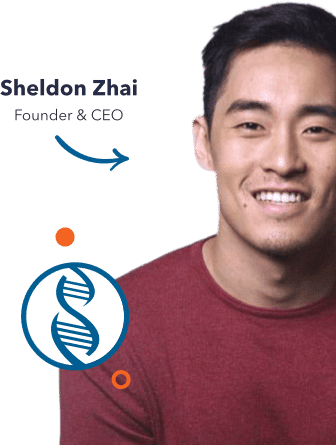SEO & Content Marketing
8 Minutes
A Life Sciences Content Marketing Funnel
A Marketing Funnel for Life Science Companies

Overview
This strategy is ideal for life science companies that are targeting lab researchers and scientists as their customers.
Our 2016 roll out strategy is designed to explode your organic traffic and e-mail list by leveraging content marketing, LinkedIn and remarketing techniques. The above marketing funnel looks complicated, but in fact, it’s dead simple.
It all starts with the content. Providing excellent resources and tools to your potential scientist customers for free will substantially increase your brand awareness and trust, and establish your company as an industry expert. Just think of Thermofisher, Genscript or Abcam. The Resources and Support sections of their websites are jam packed full of bioinformatics tools, guides, protocols, posters, video tutorials and more. This is a huge part of their online success and domination of the search engines.
Here’s the proof. This is the traffic profile of www.thermofisher.com:

Their average monthly traffic is over 2 million, and 61% of that traffic comes from organic search. A majority of this organic traffic is directed to the resources and tools that they provide.
Next…..is driving traffic to that content, either through the search engines, or through social media, in particular LinkedIn, which is most frequently used by your scientist prospects. This will involve optimizing the created content for those platforms.
After that…..is formatting your content to drive e-mail opt-ins. Life scientist researchers indicated (in a report surveying 1000 life scientists) that e-mails providing promotional offers are the most valuable tool to help them find products for their research. This is why growing an e-mail list is so important to life scientist vendors.
Finally, those website visitors that said “no” to the e-mail opt-in will be retargeted using Google remarketing. Read on to learn how we use this to dramatically increase conversions in PPC marketing.
So, lets get started with the breakdown.
Content Creation

The content that you create to drive traffic can come in many different forms: a white paper on the newest drug discovery technology, an elegant poster displaying the apoptosis pathway, or a bioinformatics tool used to design gRNA.
The essential part of any of these resources is that they provide VALUE to your potential customer. By providing value, you will be reinforcing your brand as an industry thought leader. Next time these potential customers require a product or service based around the topic of your created content, guess who will pop into their head? Your company.
80% of our sales leads and 50% of our bookings are generated from our (educational marketing) program.
-David Levin, VP of Marketing for Clinipace Worldwide
Inspiration for the content that you create should come from keyword research, customer feedback, social media trends, and competitors’ content.
We have found that one of the best types of content to create in life science is a comprehensive guide based around one topic. The guide should contain several sections and sub-sections spread across several webpages, each targeting a specific sub-topic.
Something like this:
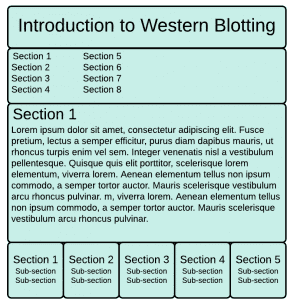
Take a look at AbD Serotec’s Guide: Introduction to Western Blotting. This layout is perfect. The reasons for this format are to drive traffic and e-mail opt-ins. This will become clear as you read on.
Traffic
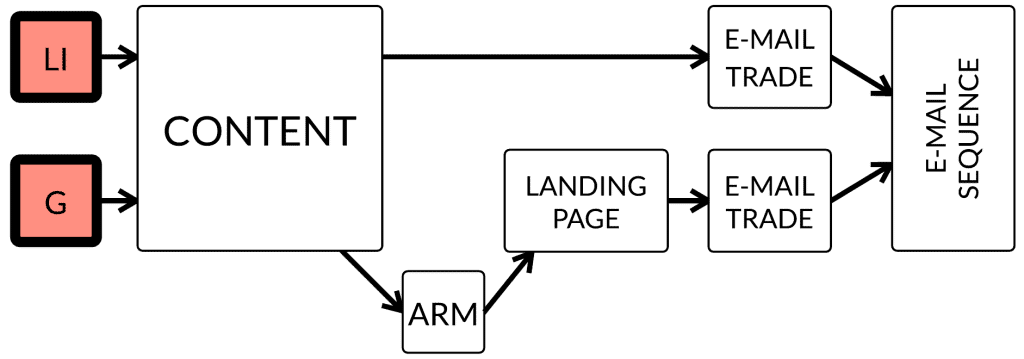
For this marketing funnel, we will be focusing on driving organic traffic to the content.
GOOGLE TRAFFIC
Lets look back at AbD Serotec’s Guide. This resource, and other resources formatted in the same way, are fantastic for ranking in the search engines. This is because each section and sub-section is targeted to rank for a particular keyphrase. The more keyphrases that you can leverage, the more traffic that you will drive from the search engines. If keywords and sections are selected carefully and with thorough research, this can be very effective.
As this entire resource is based around Western Blotting, it is so comprehensive and valuable in the “eyes” of Google that it currently ranks #3 for “western blot.” This keyword has an average monthly search traffic of 60,500!
Tools like Google’s Keyword Planner, SEMrush and Moz Pro are essential for performing your keyword research, to leverage as many high traffic keywords as possible.
LINKEDIN GROUPS
LinkedIn is the second most used social media platform for life scientists. The first is Research Gate, but LinkedIn is far more flexible to implement marketing strategies. It has also been identified in the 2014 Bioinformatics Content Marketing Report that 21% of researchers use LinkedIn as their preferred source for sharing online content.
One of the best ways to take advantage of LinkedIn is by joining LinkedIn groups and sharing your new content in these groups. There are countless biotech groups that are created to discuss and share biotech related topics and news. Perfect for your newly created content.
There are some more general biotech groups with huge member bases:

And there are also many smaller groups aimed at discussing more specific topics:

Any LinkedIn account can join up to 100 groups, so there is potential to put your content in front of a huge targeted audience. However, care should be taken when joining these groups: LinkedIn can place restrictions on your account if you join too many groups at once. It is also important that your profile is in good shape so that you are accepted into the groups, as they can be very exclusive.
The way you display your content is also crucial. If the administrators of the group see the content as salesy or spam, they can remove you without warning. Guidelines are often given for this in the group description.
Make sure that your developer updates the open graph meta tags of the content to ensure that the correct image, title and description are displayed when the content link is shared.

WHAT ABOUT PAID TRAFFIC?
Of course you can use paid ads, but we would suggest creating separate landing pages for this to ensure a higher ROI for each click. An even more effective strategy for paid traffic is to use remarketing which is used later in the funnel.
DON’T HAVE TIME TO LEARN THIS?
E-mail Opt-Ins
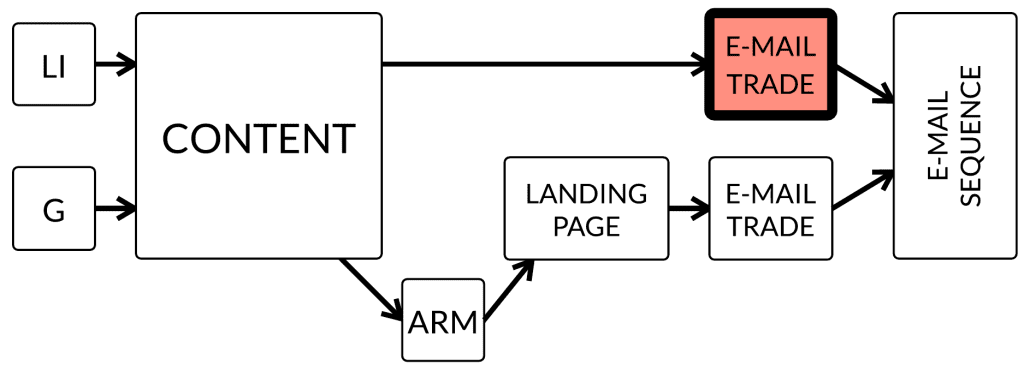
Now, we have reaped the benefits of large amounts of targeted (scientist) traffic. It is now time to turn that targeted traffic into targeted leads by capturing the potential customer’s e-mail information.
Here’s how.
THE VALUE BOMB
Let’s return to the guide layout.

You may have noticed that there is a list of sections (and sub-sections) of the guide at the top and bottom of the webpage, and these are links to the indicated sections. This layout will be consistent for every single section of the guide. A user may assume that this is for easy navigation through the guide, and it is.
But, there is another reason.
This list of sections is there to demonstrate the VALUE of the guide. What’s important about this layout is not only that the VALUE of the guide is there in the content, but that the VALUE is readily apparent when someone scans through the page. If the additional sections had not been displayed so boldly, or if the whole guide was displayed on one webpage, it would be harder to perceive the value.
So, how does this create e-mail opt-ins?
Well. When someone goes to a page and sees an enormous amount of value, it creates tension if they cannot possess that value. The brain does not like seeing a lot of value that it cannot possess. It overwhelms the user, because they want to possess the content NOW, but of course, they do not have time to read the entire resource RIGHT NOW.
So, what we do to relieve this tension, is to create a Call-To-Action, with the opportunity to download the entire resource in exchange for an e-mail trade. The best place to create these CTAs is directly above or below the section lists.
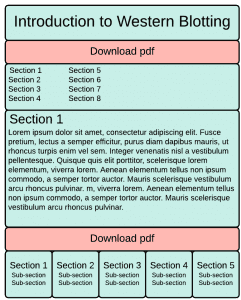
This has been proven to be an amazing technique for generating huge e-mail opt-ins. We actually discovered how effective this layout was accidently when we got incredible e-mail opt-ins that we had not anticipated.
AdWords Remarketing

Now this is where the funnel gets interesting.
By using Google’s remarketing lists feature, you can target your display ads to visitors who landed on your guide via Google search, LinkedIn, or any other means, but did not opt to download the guide. This is POWERFUL! By targeting these previous visitors around the web with display ads, you know that you are targeting individuals that are already interested in the topic of the resource. This results in fantastic conversions.
Here’s how to set it up…
- Put Google Analytics code on all your guide pages.
- Link your Google Analytics account to Adwords.
- Create a Google remarketing list for all visitors that landed on the guide.
- Create a banner ad that offers a free download of the guide.
It is important not to send these more expensive visitors back to the guide. These visitors should be sent to a landing page that is optimized for e-mail capture.
The main features of the landing page should be a simple picture of the guide, a few bullet points of the benefits of the guide, and a direct CTA to opt-in for the free guide.
There should be no external links for the user to leave the page. The user should have one option, and that is to opt-in to receive the guide in exchange for their e-mail. You have paid for this user, so it is important that you get something out of it!
THE RESULT
The best part of this strategy is that you are left with an e-mail list of highly targeted leads. You can now begin an e-mail sequence of promotions on services or products that you know the lead is interested in. E.g. if the lead opted-in to download a guide related to CRISPR-Cas9, you can tailor your e-mail sequence to promote CRISPR-Cas9 products or other gene editing services.
Furthermore, you are left with an asset in the resource that you decided to create. This resource will continue to attract organic traffic through the search engines. Additionally, it can be continuously repackaged and used as lead bait in other marketing funnels.
WRAP UP
The strategy is ideal for life science companies looking to broaden their online presence and generate some invaluable leads.
However, if this looks overwhelming to you, or if you don’t have accounts in these networks, or if you don’t have the time to learn how to use each of these networks, then you should let us make it hands-free for you.
Our agency specializes in online marketing for life science companies. Our impressive client list in the life science industry speaks for itself. So, if this is for you, find out more about our services and schedule a free 1-on-1 consultation.




